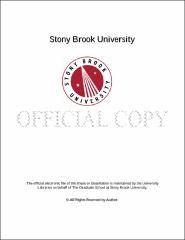| dc.identifier.uri | http://hdl.handle.net/11401/77722 | |
| dc.description.sponsorship | This work is sponsored by the Stony Brook University Graduate School in compliance with the requirements for completion of degree. | en_US |
| dc.format | Monograph | |
| dc.format.medium | Electronic Resource | en_US |
| dc.language.iso | en_US | |
| dc.publisher | The Graduate School, Stony Brook University: Stony Brook, NY. | |
| dc.type | Dissertation | |
| dcterms.abstract | My dissertation traces a form of call and response between New York City and Naples in the 1970s and 1980s. It foregrounds the importance of the `blues' in the traffic of sound, images and oppositional ideas between these two cities located on the same geographical parallel. The blues here is understood as a musical style and feeling, as well as an affect of trauma, loss, memory and an intimate relationship that artists and activists established with their city spaces in the age of the so called " urban crisis." It proposes a " blutopia," based on utopian/dystopian tensions that promote alternative forms of knowledge, or a bluesology. While I focus on the 1970s and 1980s, and on New York and Naples, I move across time and space tracing multiple histories that connect past and present, local and global. My dissertation argues that cultural expressions and activism in the 1970s and 1980s in New York and Naples were part of a " blues continuum" that began with the early slave rebellions, the Maroon communities in the Americas, the multiethnic revolt of Masaniello in Naples and continued with Pan-Africanism, black liberation movements, postcolonial thinking, and urban struggles in both cities. Like a deejay working at the turntables I mix sounds, poetry and filmic images with stories of resistance and urban survival. Like " a botanist of the asphalt" I imagine walking on the streets of New York City and Naples listening to the " small voice of history." Sustained by the saxophone sound of James Senese, the electro funk of Afrika Bambaataa, the rappin' style of Sandra María Esteves, the activism of Evelina López Antonetty, Lillian López and Richie Pérez, the urban struggles of the mothers against heroin, the murals of Felice Pignataro, the echo of dub from Jamaica to New York and to Naples, the blue maps of Bobby Womack and Mario Merola, and the futuristic impulse in Blues metropolitano and The Brother from Another Planet, this is a story of unexpected and critical connections between the black Atlantic, " Nuestra América" and a fervently creolized Mediterranean. | |
| dcterms.abstract | My dissertation traces a form of call and response between New York City and Naples in the 1970s and 1980s. It foregrounds the importance of the `blues' in the traffic of sound, images and oppositional ideas between these two cities located on the same geographical parallel. The blues here is understood as a musical style and feeling, as well as an affect of trauma, loss, memory and an intimate relationship that artists and activists established with their city spaces in the age of the so called " urban crisis." It proposes a " blutopia," based on utopian/dystopian tensions that promote alternative forms of knowledge, or a bluesology. While I focus on the 1970s and 1980s, and on New York and Naples, I move across time and space tracing multiple histories that connect past and present, local and global. My dissertation argues that cultural expressions and activism in the 1970s and 1980s in New York and Naples were part of a " blues continuum" that began with the early slave rebellions, the Maroon communities in the Americas, the multiethnic revolt of Masaniello in Naples and continued with Pan-Africanism, black liberation movements, postcolonial thinking, and urban struggles in both cities. Like a deejay working at the turntables I mix sounds, poetry and filmic images with stories of resistance and urban survival. Like " a botanist of the asphalt" I imagine walking on the streets of New York City and Naples listening to the " small voice of history." Sustained by the saxophone sound of James Senese, the electro funk of Afrika Bambaataa, the rappin' style of Sandra MarÃa Esteves, the activism of Evelina López Antonetty, Lillian López and Richie Pérez, the urban struggles of the mothers against heroin, the murals of Felice Pignataro, the echo of dub from Jamaica to New York and to Naples, the blue maps of Bobby Womack and Mario Merola, and the futuristic impulse in Blues metropolitano and The Brother from Another Planet, this is a story of unexpected and critical connections between the black Atlantic, " Nuestra América" and a fervently creolized Mediterranean. | |
| dcterms.available | 2017-09-20T16:53:25Z | |
| dcterms.contributor | Lebovics, Herman | en_US |
| dcterms.contributor | Lim, Shirley Jennifer | en_US |
| dcterms.contributor | Masten, April | en_US |
| dcterms.contributor | Chambers, Iain. | en_US |
| dcterms.creator | Buffa, Alessandro | |
| dcterms.dateAccepted | 2017-09-20T16:53:25Z | |
| dcterms.dateSubmitted | 2017-09-20T16:53:25Z | |
| dcterms.description | Department of History. | en_US |
| dcterms.extent | 342 pg. | en_US |
| dcterms.format | Monograph | |
| dcterms.format | Application/PDF | en_US |
| dcterms.identifier | http://hdl.handle.net/11401/77722 | |
| dcterms.issued | 2014-12-01 | |
| dcterms.language | en_US | |
| dcterms.provenance | Made available in DSpace on 2017-09-20T16:53:25Z (GMT). No. of bitstreams: 1
Buffa_grad.sunysb_0771E_11813.pdf: 8382004 bytes, checksum: b627ac95d1e638c32405344f4afc3b2f (MD5)
Previous issue date: 1 | en |
| dcterms.publisher | The Graduate School, Stony Brook University: Stony Brook, NY. | |
| dcterms.subject | American history | |
| dcterms.subject | Activism, African Diaspora, Cinema, Music, Naples, New York | |
| dcterms.title | The Blues Continuum: New York Calls - Naples Responds | |
| dcterms.type | Dissertation | |

